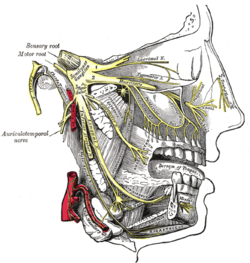Anatomy of the posterior superior alveolar nerve:
- Origin: Arises from the maxillary nerve within the pterygopalatine fossa.
- Course: Exits the pterygopalatine fossa through the pterygomaxillary fissure, passes within or upon the posterior wall of the maxilla, descends on the tuberosity of the maxilla, and gives off twigs to the gums and neighboring parts of the mucous membrane of the cheek.
- Distribution: Provides sensory innervation to the upper/maxillary molar teeth, associated gingiva of the vestibule, and the maxillary sinus.
- Teeth innervated: Innervates the second and third maxillary/upper molar teeth, and two of the three roots of the maxillary/upper first molar tooth.
Clinical significance of the posterior superior alveolar nerve:
- Anesthesia: A posterior superior alveolar nerve block can anesthetize the mesiobuccal root of the maxillary/upper first molar tooth approximately 72% of the time.
Related nerves:
- Alveolar nerve (Dental nerve)
- Superior alveolar nerve (Superior dental nerve)
- Anterior superior alveolar nerve (Anterior superior dental nerve)
- Middle superior alveolar nerve (Middle superior dental nerve)
- Inferior alveolar nerve (Inferior dental nerve)
The posterior superior alveolar nerves (also posterior superior dental nerves, or posterior superior alveolar branches[citation needed]) are sensory branches of the maxillary nerve (CN V2). They arise within the pterygopalatine fossa as a single trunk. They run on or in the maxilla. They provide sensory innervation to the upper molar teeth and adjacent gum, and the maxillary sinus.
| Posterior superior alveolar nerve | |
|---|---|
 Distribution of the maxillary and mandibular nerves, and the submaxillary ganglion. (Posterior sup. alveolar labeled at center.) | |
 A sketch of the Posterior Super Nasal Nerve | |
| Details | |
| Innervates | maxillary sinus, molars, dental alveolus |
| Identifiers | |
| Latin | rami alveolares superiores posteriores nervi maxillaris |
| TA98 | A14.2.01.050 |
| TA2 | 6235 |
| FMA | 75545 |
| Anatomical terms of neuroanatomy | |